Disclosure: Meeple Mountain received a free copy of this product in exchange for an honest, unbiased review. This review is not intended to be an endorsement.
Queen Margaret is in poor health. Beside himself with worry, King Nepomuk II summoned the royal medicus who suggested that a change of climate might be just the ticket to restore her humors. After a successful test run on the family estate, the King decided he needed to make things more permanent. What the Queen really needed was a castle and there was no better place for it than right smack dab in the center of the valley of Queensdale. Situated between the rolling plains to the south, the lush forest land to the west, and the sea to the east, this was the perfect location. All he needed now were some trustworthy vassals and a willing workforce to make his dream a reality.
Welcome to The Rise of Queensdale.
Overview
In The Rise of Queensdale, players take on the roles of nobles tasked with building up the valley of Queensdale and constructing a castle in which the Queen will live out the rest of her days. Each player begins with a small fiefdom under their control and 5 dice in hand. Each die features symbols for lumber, stone, clay, guilders, and actions.
Every round players roll their dice and take turns designating those dice for different actions. For instance, to collect clay, a die with the clay icon would be placed into the clay area. In addition to the basic resources, there are several different actions available that can only be activated using the action symbols on the dice; actions like hiring workers or trading gold for resources. And these are just a small sampling of the actions that are available to you. In fact, since this is a legacy game, more actions will be added as you play through the campaign.
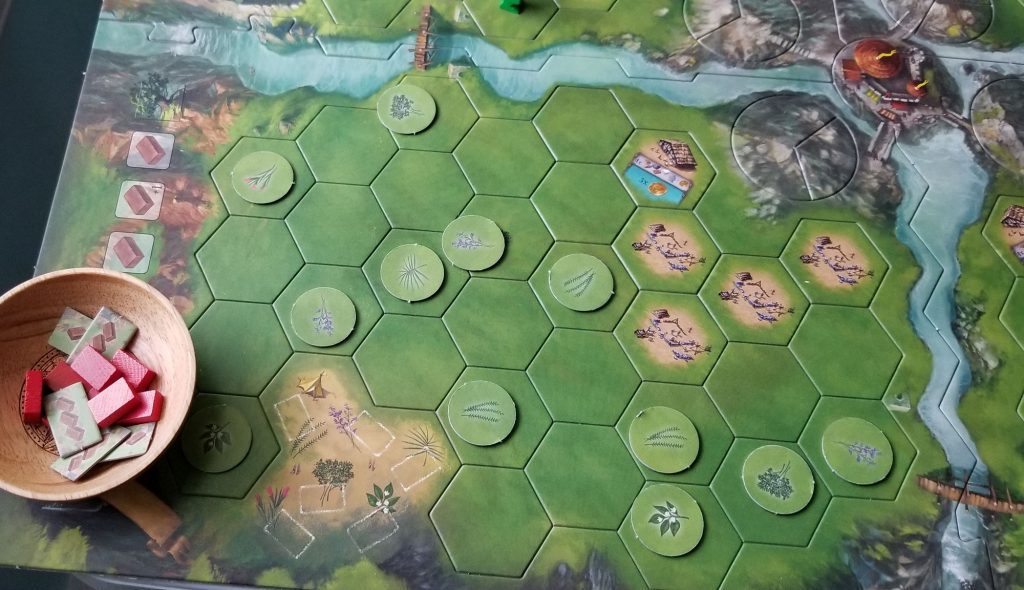
Each person begins the game with the same goal – to score 10 points. But as the campaign moves along and players graduate into different epochs, a player’s goal for any particular game might be different from everyone else’s. While one person might be trying to score 22 points another might only be able to bring the game to conclusion by scoring 50. The ultimate goal of the campaign is to reach epoch 9 and be the first person to score a total of 90 points in a single game. Only through clever dice placement, careful resource management, and the occasional bit of dumb luck can you become the victor. The race is on! Start building that castle!
If you’re just interested in what I think about The Rise of Queensdale (so far), then feel free to skip down to the Thoughts section. But if you’d like to get a sense of how the game is played, read on and let me reassure you that I aim to keep this review spoiler free. Anything that I discuss in this review will be something that you will encounter in your very first game.
Setup
The setup for every session of The Rise of Queensdale will always include these standard components. In future games, new concepts will emerge that will alter this basic setup. First, the game board will be assembled and placed into the middle of the table with the Actions board and the Fame board set close by. The various resource bits are placed into their appropriate areas (guilders placed into the guilders area, for instance). Next, the herb tiles are shuffled face down and placed randomly into the gaming area on top of the small shrubbery icons. Then a number of figurines are placed into the draw bag. In your first game, there will be 8 pink gleemen, 8 brown craftsmen, and a single white courier pawn. The bag is then set aside until it is needed.
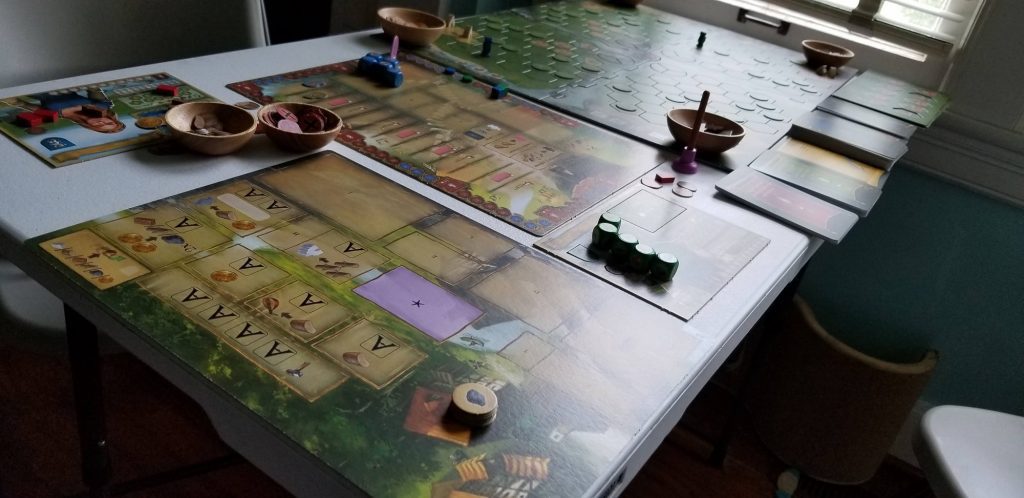
After the play area has been arranged, the various cards are set out. Some of these must remain in order while other cards like the Courier cards are shuffled and placed face down into a deck. Then each player takes the character board and playing pieces of their chosen color. Their morale and fame counters are placed onto the Fame board while their Scout is placed on top of the tent that matches their chosen color. Each player will also begin each game with a single herb hut placed onto the herb icon of their choice. I’ll talk more about herbs and herb huts later.
For the first game only, each player receives one red seal and three guilders to begin the game. Guilders, seals, gleemen, and all of the other game terminology that I have glossed over will be explained in due time.
Once all of this setup has been done, the starting player is determined and you’re ready to begin playing.
An Epoch Beginning
The Rise of Queensdale is played in a series of epochs and, as stated previously, not every player is going to have the same goals each time the game is played. At the start, though, all players are going to have the same goal… score ten fame points. These points can be scored through different actions and the point breakdowns for these actions is shown on each player’s board in the epoch goals area. This section of the player board can be popped out and will be replaced with different goals as the players progress over the course of the campaign.
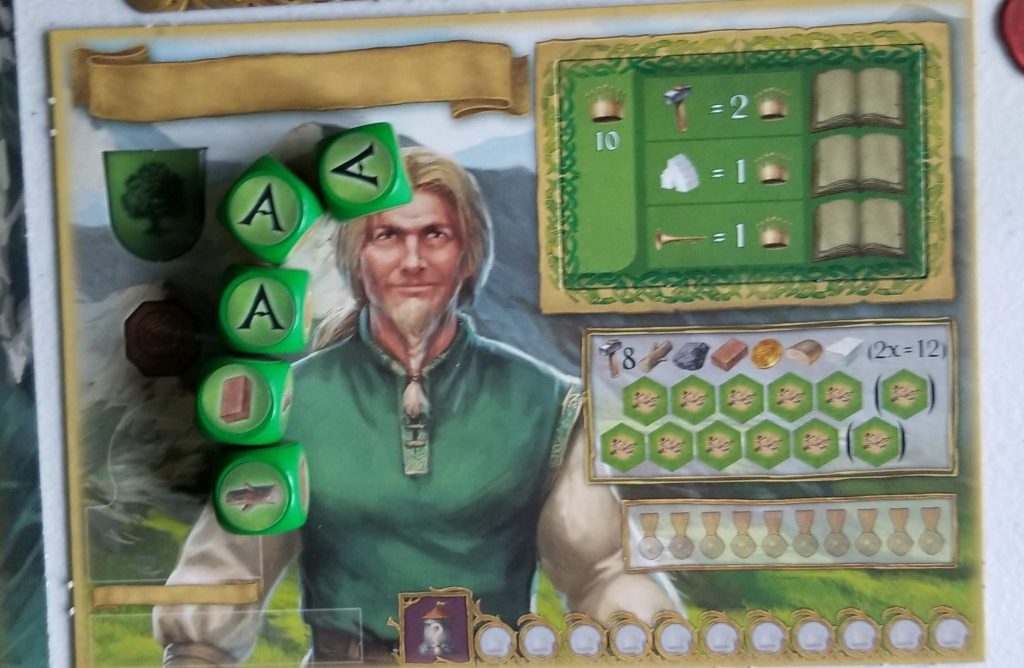
Before a single die is rolled, each player will have an opportunity to go shopping at the grocer, a sticker sheet which allows die face upgrades. Spending a single red seal, for instance, will allow the player to replace one of their die faces with an upgraded version of the same action (turning a collect wood action into a collect wood OR clay action, for example) or a different action entirely. Next, the applicable Story card, green or yellow, is read aloud and the instructions are followed. Then the players roll their dice and it’s off to the races. At the beginning of the first game, there will not be any cards read. Players will alternate placing one die at a time until all dice have been placed.
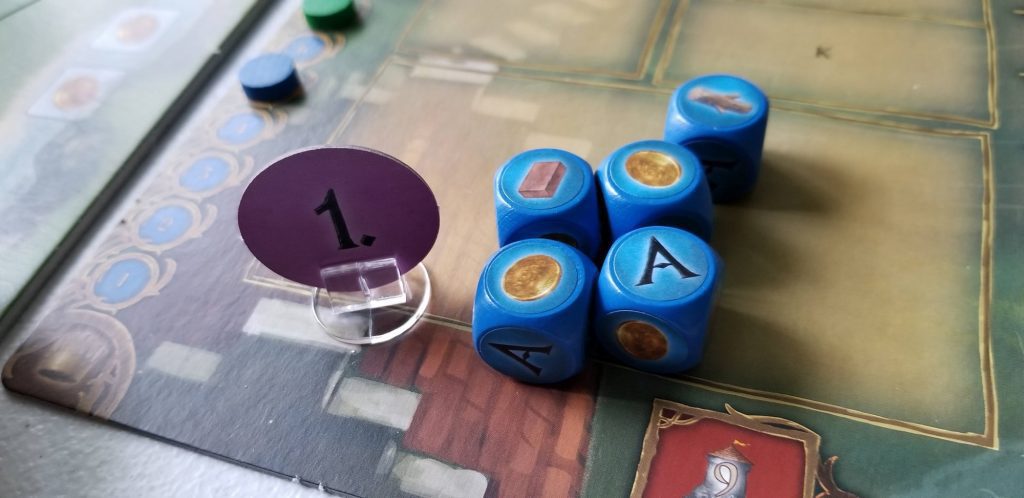
At the start of the campaign, players score points for three basic actions – building, raising morale, and constructing herb huts. Performing any of these actions requires the expenditure of resources and acquiring those is pretty easy. If a die face comes up containing the image of a resource, then the player can place that die onto an open resource space of the matching type and take the applicable resource(s). After a player has accumulated some resources, they will spend them using the “action” die faces. So let’s discuss these different actions briefly so you’ll have a sense of how everything ties together.
The Action Board
The different actions can be broken down into two rough categories – actions that get you something and actions where you spend resources to do something. As I go through these actions, you may encounter terminology that’s unfamiliar. Keep reading and everything will be explained.
In the “get something” category are actions that get you bread or guilders. In addition to these two, there is a Scout movement action that lets you move your Scout across the game board. Each time the Scout encounters an herb that the player has built the proper herb hut for, that herb token is flipped over and the player receives something in return – usually a resource or a fame point, but sometimes a chance to draw a Clairvoyant card. Clairvoyant cards enter the game in numerical order. Each one has a story section that is read aloud and another section that is kept as private knowledge. This private knowledge is typically something along the lines of “Hey, this thing here will happen at some point in the game most likely, so if you’re prepared for it, it’s going to really benefit you”.
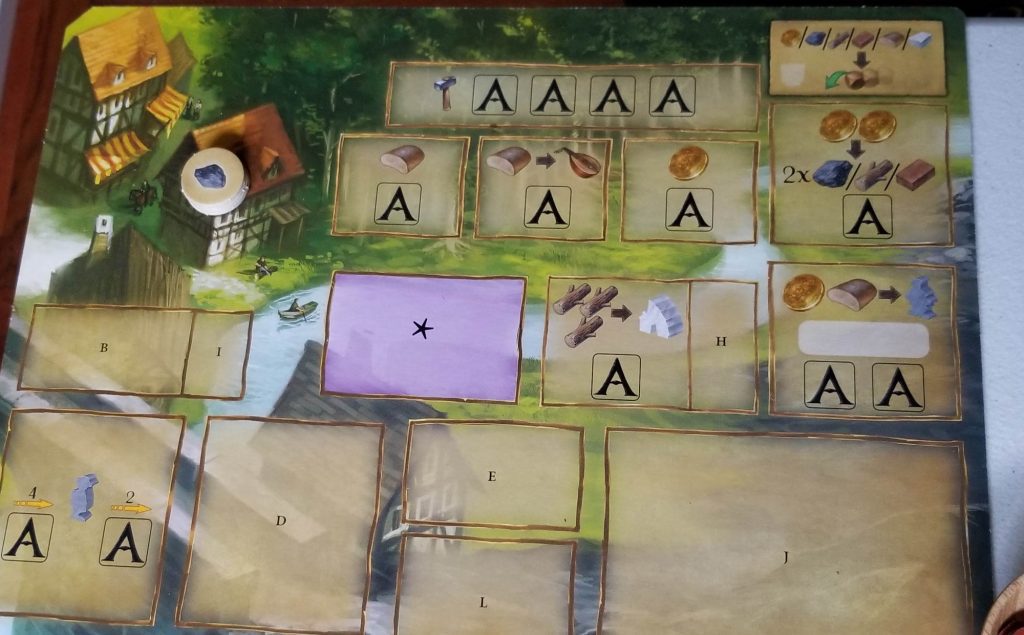
In the “spend resources” category are actions that allow you to exchange items to build new herb huts, construct new buildings, trade guilders for resources, spend bread to raise morale, and spend bread and guilders to draw figurines from the bag. Building huts and adding buildings to your fiefdom will earn you fame points. The number of points earned depends entirely upon the epoch you have currently achieved. These values will be shown on the epoch goal card of your character sheet.
Usually you will be using the “action” die face to perform actions on this board. However, there is a method for you to use other dice here as well… at a cost. For example, if you’ve rolled up a die showing the lumber die face, you can pay a lumber to use this die as if you had rolled up the “action” die face instead. If the die face showed clay, you’d pay a clay instead. Likewise for stone or guilders. In addition to this method of die roll mitigation, you can also pay a single resource of your choice at any time to reroll as many of your dice as you’d like.
Buildings
Each player begins the game with a single building in their fiefdom and the base of a tower which is segmented into three pieces. This starting building is a farm and will allow players to convert items into guilders at the end of the game and allow them to carry three of those guilders into the next game. Aside from the abilities provided by specific buildings, there is no method for carrying items over from one game to the next (with the exception of seals). This is just one of the reasons that constructing buildings is important. Other types of buildings will provide you with other types of benefits. The more buildings you have and the more varied they are, the more options you have at your disposal to grow and thrive.
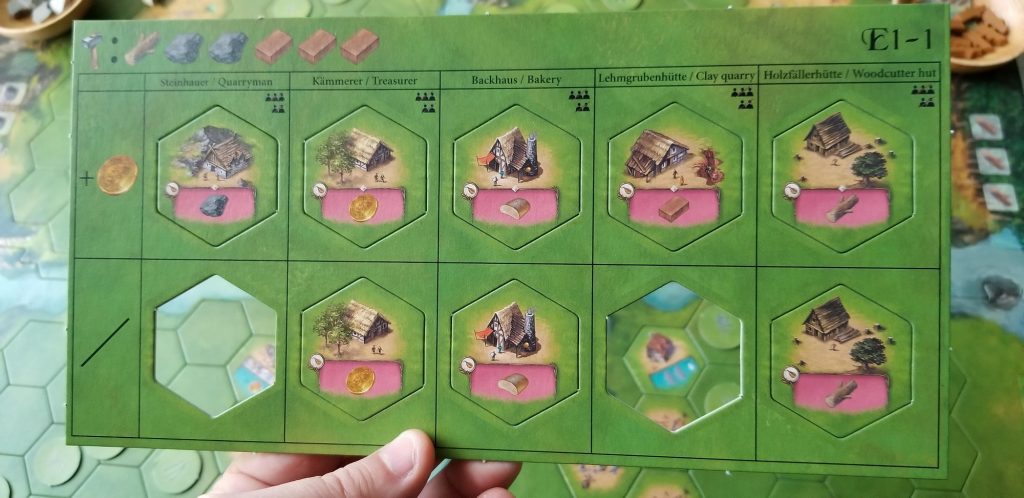
When you begin your very first game, there are only two types of buildings available for you to construct – storage buildings that let you carry certain items over and manufactories that will produce goods whenever certain morale thresholds are reached. These buildings are contained on punch boards and the costs for constructing them are listed on the punch board. When a person chooses the building action from the action board, they pay the resources to the supply, remove the tile from the punch board, and then add the tile to their fiefdom following certain placement rules. This affords them the exciting opportunity to utilize one of the most distinct physical game components I have ever seen in any game ever: The Royal Plunger.

The plunger is used to remove one of the build site tiles from the game board so that it can be replaced with something else. These removed tiles are discarded because they won’t be needed anymore. Each player begins the game with only four build sites but opportunities will arise in future games to add even more. Whenever a player builds something, they will earn fame points for doing so.
And speaking of morale thresholds…
Morale
Aside from building, raising the morale of your people is one of the most lucrative things that you can do in the game both in terms of fame and resources. The morale track is divided into several steps. As you move up the steps, you will encounter one of two icons – a trumpet or a pink rectangle. When you encounter a trumpet, your fame points will increase by the value specified on your epoch goal card. When you encounter a pink rectangle, all of your manufactories will produce whichever resources they are able to produce. If you’ve adequately prepared for these events, they can be a massive boon to you when they occur. It pays to plan wisely!
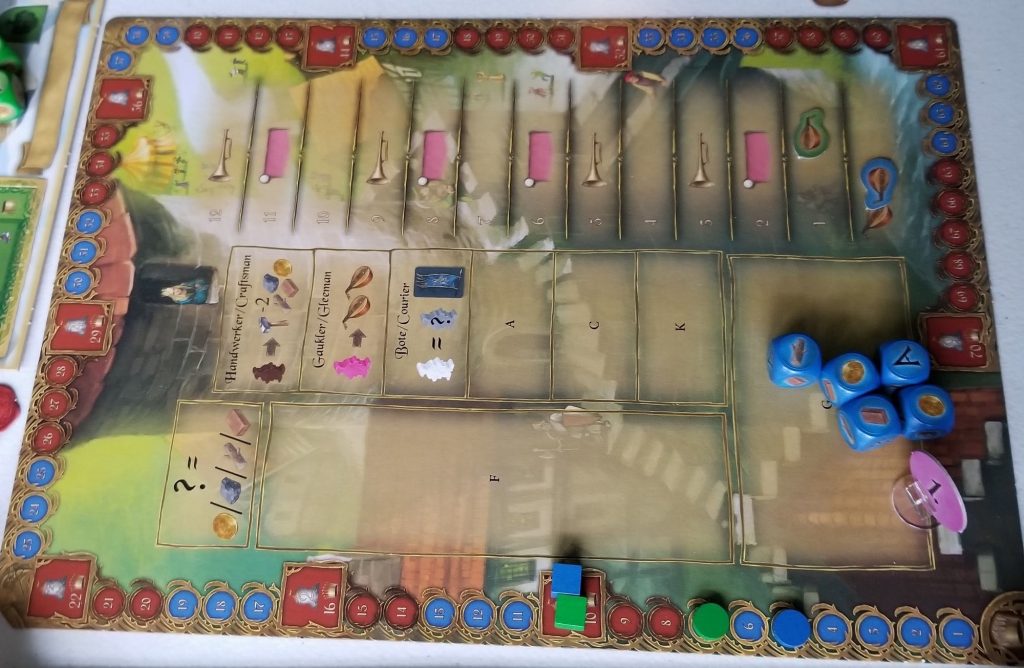
Figurines
Last but certainly not least, we come to the figurines. Each figurine drawn from the bag affords the player certain benefits. At the start of the first game, you placed three different types of figurines into the bag: craftsmen, gleemen, and a courier. Once you’ve drawn a figurine, you can keep it in front of you until you’re ready to use it for its benefit.
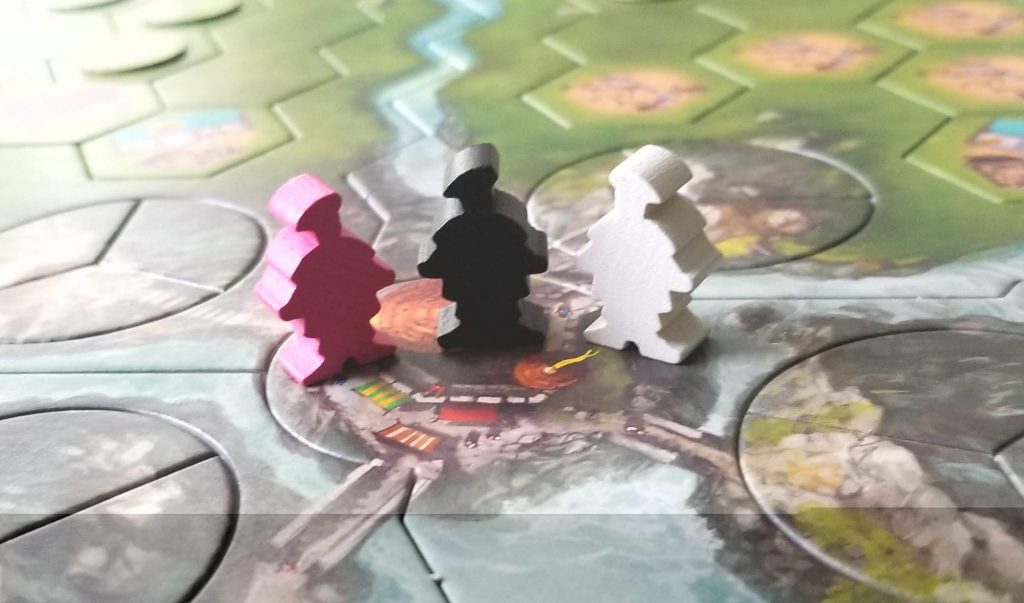
Here’s what they do:
Craftsman: discard to the center of the game board to provide a 2 resource discount on a building project. The effect is cumulative so it is conceivable that you could discard enough gleemen at the same time to construct a building for free.
Gleeman: immediately raise your morale by two steps. Like the craftsmen, the effect of these figurines is cumulative.
Courier: immediately draw a random Courier card from the deck, read it aloud, and do whatever it says. Some of these cards have permanent effects that last until the end of the current game and some occur immediately. The courier figurine itself can be used as a wildcard to represent any of the other types of figurines. Discard it to use the gleeman effect or discard it to use the craftsman effect… it’s up to you!
The End of an Epoch
The end of a game session is triggered whenever one of the players meets or exceeds their current epoch goal. Play continues until everyone has placed their last die. The player that met their goal is the winner of that game unless someone else managed to exceed them or tie with them and win the tie-breaker. Then a few end of game things occur.
First, players discard resources back to the supply until they are at their carry over limits. Next the red Epoch End card is read aloud and any instructions that may be printed there are carried out. Then a single seal is handed out to each person that did not reach their epoch goal. If any of those players managed to end the game with their fame counter in the red area directly in front of their epoch goal, they receive an additional seal.
If a player has achieved their epoch goal, they will get to select one of the tower upgrades (which will get them free stuff at the beginning of each subsequent game) for completing that epoch. If there are multiple players who have achieved their goal in the same game, the tie-breaker rules are applied and the winner gets to select first. These players will also replace their old epoch goal cards with new ones.
This cycle of games – adding or replacing things as the Story cards dictate, building up your fiefdom, and trying to meet your epoch goals before other people meet theirs continues until someone reaches and completes epoch 9. That player will win the campaign overall.
Thoughts on The Rise of Queensdale
Well, that was a lot to get through. There is nothing small about this game. From the box the game came in to the sheer amount of content contained within, the Rise of Queensdale will keep you busy for quite some time. I’m a huge fan of Inka and Marcus Brand and they certainly don’t disappoint here. The breadth of imagination, ingenuity, and cleverness they possess astounds me. The Rise of Queensdale constantly surprises me at every turn.
Before I get too far into talking about the game play, let me talk about the overall component quality. The artwork in The Rise of Queensdale is stellar. I would expect nothing less from Michael Menzel. There’s a reason I selected him as one of the best board game illustrators in the business. His artistry has an earthy charm about it and it definitely sets the mood here. I find the color scheme pleasing. The deep reds and dark greens lend the game a welcoming warmth. The iconography stands out, is easy to read, and makes sense without requiring you to constantly resort to the rule book to figure out things. And all artwork aside, the quality of these components leaves nothing to be desired. The cardboard is nice and thick, the cards have a crisp snap to them, and all of the printed material are high quality. I would expect nothing less from an Alea game.
If I had to find something negative to say, it would be that the plunger is just a tad too wide to fit onto the different sections of the tower. Lifting one of those sections out of the board was no easy task. I had to grab a kitchen knife to pry it out of its socket. Also, the epoch goal cards don’t fit into their designated spots like they should. This isn’t game changing by any means, but it would be nice if they did. In fact, these are probably the only negative things that I have to say about this game.
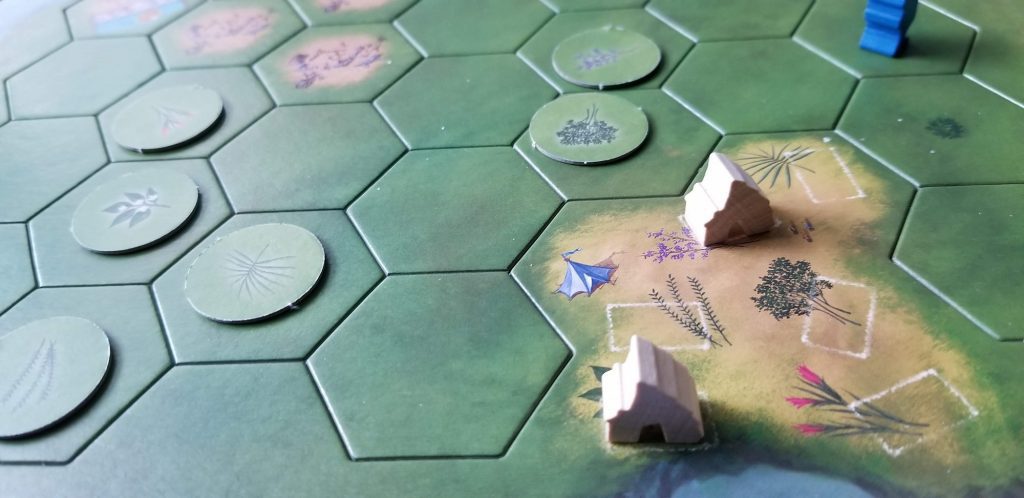
I have made no efforts to hide my dislike of luck based outcomes in my past reviews. I hate the feeling of my fate being determined by some random dice roll. It makes all of my hard work up to that point feel completely wasted. Which is why I am pleased to say that because of the dice roll mitigation in this game (discarding a resource to reroll or using resources to utilize resource die faces as actions), I never feel like my destiny is out of my control. In fact, quite the opposite. I find that having these options creates a lot of moments when I am struggling to choose between collecting a resource which might come in handy later or using that resource to take an action that will benefit me now. There are times when I want to take a specific action just so that my opponent cannot. Even though taking that action may be sub-optimal for me, sometimes it’s worth it just to deny them a move that is hugely beneficial to them. With a limited number of actions per round, though, these kinds of decisions are never easy to make.
I enjoy games that force me to think in these kinds of ways. I like that feeling of pressure as my opponent is speeding up behind me on the fame track. I love having to solve the puzzle of how to squeeze points out of the last few dice left to me so that, even if I don’t win, I can still collect two seals as opposed to just a single one. The Rise of Queensdale tests me at every turn.
My only previous legacy game experience was with Charterstone. That game incentivizes you to stretch each game out for as long as you possibly can because the more points you earn per game, the better rewarded you are at the end of the game. The Rise of Queensdale is the opposite. If you dilly-dally for too long, your opponents will speed right past you and leave you in the dust. The Rise of Queensdale is a race to the finish line, which helps keep each of your games short. A typical game of the Rise of Queensdale will usually only last 45 minutes to an hour. And that short playing time tends to lead directly into multiple back-to-back plays. It’s a perfect game for both casual gamers and hard core gamers alike.
The Brands have taken a seemingly easy rule set – roll some dice and place them – and have constructed something wonderful and complex around it. My wife and I are only seven games into our campaign and I can’t wait to see what happens next. The Rise to Queensdale is a sheer delight to play and I am loving every minute of it. The price tag is a bit steep, but it’s well worth the cost of entry. I highly recommend this game.


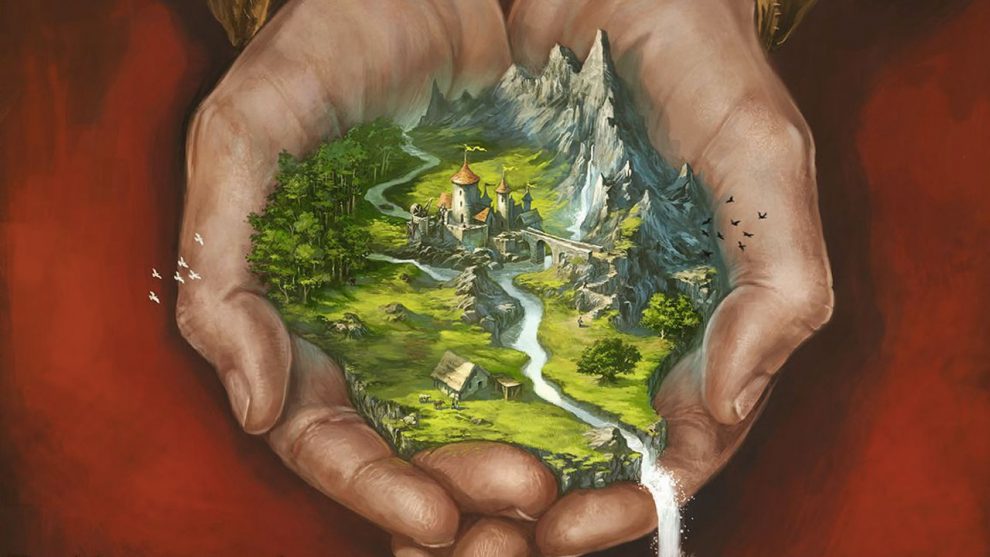
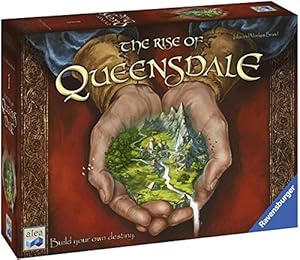








Add Comment